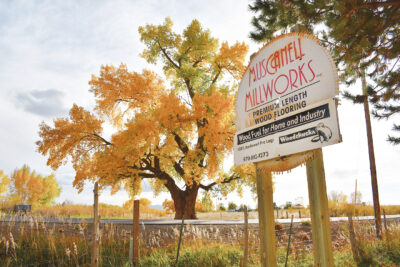Photos and information provided by Chris Fehr
Woodstock Inn & Resort, in Woodstock, VT, served as the site recently of the annual spring meeting of the New England Lumbermen’s Association (NELA).
A business discussion highlighted the event. NELA President Bob Chase of Quabbin Timber served as moderator.
About The Overall Market:
The general consensus about the overall market reflected concern regarding the weather in the Northeast, which was extremely difficult this past winter. Unseasonably wet timber tracts and warm temperatures detrimentally affected logging and log hauling.
One attendee shared that large builders he markets to, like Toll Brothers and Ryan Homes, reported that revenue is down due to less building, but margins are up as home prices remain high and lumber prices remain down.
In reference to the previous point, another attendee was quoted as saying, “Everybody is doing well except the sawmills.”
About The Sawmills:
At the time of the NELA meeting, log decks seemed in good shape, but earlier in the year one representative noted they endured a two-week shutdown due to a lack of logs. Now at his facility, cost control and mill efficiency improvements are getting considerable attention, which they view as key elements to survival.
A Vermont representative said lumber prices must increase as operating costs are now at an all-time high. Regarding that, another sawmill rep observed that the new metric seems to be to measure pre-COVID versus post-COVID for operating costs. His business also handles pine, which appears to be returning to standard seasonal markets with Selects retaining “red hot” status in the market.
About The Flooring Market:
Attendees noted that demand is supporting a viable market, but it is down in comparison to previous market cycles. Particularly, Hickory flooring demand has greatly fallen and overall flooring pricing is challenging.
Some flooring manufacturers lamented that they are planning day-to-day, week-to-week.
Attendees believe prices will rise for lumber but it is strictly supply driven due to mill shutdowns, curtailed production and/or log shortages due to weather.
One NELA attendee said his flooring mill is currently running at full capacity but they are not pushing for more production.
Overall consensus reflected that flooring production is down year over year and there was shared concern that real wood products continue to lose a lot of ground to alternatives. Similarly, cabinet producers are seeing a significant shift away from solid wood. One cabinet producer from Pennsylvania said that a few years ago, 5-7 percent of their production was in MDF cabinets. Today, that number is about 45 percent and increasing.
At the time of this writing, though, solid wood flooring inventory was mostly good, noted one attendee, who cited Maple as an exception. There was an over-abundance of this species.
Another flooring representative noted that his varnish supplier is only working two days a week, which is not a good sign overall for the industry.
He additionally noted that White Oak lumber prices are too high for them to make any money and, subsequently, his company has received resistance from their customers to raise prices.
About Distribution Yards:
Among the distribution yards represented at NELA, one representative said every month has exceeded their forecasts from 2023. He feels most of this is driven by the ultra-high-end market, for example, the coastal homes that generally require 2 years to build and cost of lumber is a small factor in the overall cost of the project.
About The Labor Industry:
Although no major changes are forecast currently in the housing industry, NELA attendees commented that labor is an issue among builders. “Build it faster and cheaper,” is the mantra, they stated. They have heard from clients, as well as observed, that the current labor force among builders isn’t trained to install higher-end woodwork/cabinets/flooring. This is influencing higher-end new home construction in a detrimental manner.
About Pallets, Railroad Ties And Truck/Trailer Flooring:
These segments of the lumber industry have seen a decrease in either production or demand. Railroad tie representatives acknowledged that their buying patterns are shifting too. For example, whereas the prior two years were geared toward rebuilding inventories, now their goal for the next six months is to maintain existing inventories.
Pallet reps in attendance noted that while they have not lost customers, new customers are limited. General speculation is that the pallet industry will experience a downturn to pre-COVID 2019 levels.
The truck trailer flooring industry is adjusting its 2024 forecast, said attendees, to 25-30 percent lower than what was predicted in the fall of 2023. They said most customers are waiting for interest rates to drop before investing more but are still anticipating growth over the next five years. They are also seeing a shift in demand toward trucks transporting in North America due to the re-shoring from China to Mexico, which is spurring a shift in shipping demand away from containers going overseas.
Lastly, About The Export Market:
One attendee from New Hampshire said he believes the economy in China is worse than what is being reported. Otherwise, he is anticipating a stronger demand for uppers; however, No. 1 Common appears overstocked. Europe, he said, is pushing back on high White Oak pricing and his company is seeing more customers transitioning to European White Oak and North American Red Oak.
A different exporter who sells into China said (at the time of this NELA meeting) it had been a brisk couple of weeks since the business activity returned following the Chinese New Year. Whether or not it could continue remained to be seen. Overall, he is expecting a slower year in 2024. China’s inventories were low going into this year. His sales to the Europeans are lagging as the EU market struggles due to political strife in Ukraine and Gaza, as well as other factors. The same exporter said his lumber production is down and a number of green sawmills have closed because they are having trouble making a profit, which impact lumber’s availability.
Another exporter said his log volumes are down (attributed to weather) so his log export volume is down.
Also, due to the unavailability of Ash, demand for Maple and Red Oak is increasing. Walnut demand remains strong.
NELA’s next meeting will be June 5 in Utica, NY. For more information, please contact Chris Castano at ccastano@mainewoods.net






















